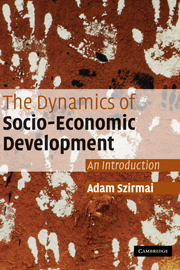Book contents
- Frontmatter
- Contents
- List of figures
- List of tables
- List of boxes
- Preface
- List of abbreviations
- Acknowledgements
- Chapter 1 Developing countries and the concept of development
- Chapter 2 Development of the international economic order, 1450–2000
- Chapter 3 Growth and stagnation: theories and experiences
- Chapter 4 Technology and development
- Chapter 5 Population and development
- Chapter 6 Health, health care and development
- Chapter 7 Education and development
- Chapter 8 Economic development, structural transformation and primary exports
- Chapter 9 Industrial development
- Chapter 10 Agricultural development and rural development
- Chapter 11 State formation and political aspects of development
- Chapter 12 Cultural dimensions of development
- Chapter 13 The international economic and political order since 1945
- Chapter 14 Foreign aid and development
- Bibliography
- Author index
- Subject index
Chapter 10 - Agricultural development and rural development
Published online by Cambridge University Press: 05 June 2012
- Frontmatter
- Contents
- List of figures
- List of tables
- List of boxes
- Preface
- List of abbreviations
- Acknowledgements
- Chapter 1 Developing countries and the concept of development
- Chapter 2 Development of the international economic order, 1450–2000
- Chapter 3 Growth and stagnation: theories and experiences
- Chapter 4 Technology and development
- Chapter 5 Population and development
- Chapter 6 Health, health care and development
- Chapter 7 Education and development
- Chapter 8 Economic development, structural transformation and primary exports
- Chapter 9 Industrial development
- Chapter 10 Agricultural development and rural development
- Chapter 11 State formation and political aspects of development
- Chapter 12 Cultural dimensions of development
- Chapter 13 The international economic and political order since 1945
- Chapter 14 Foreign aid and development
- Bibliography
- Author index
- Subject index
Summary
Relationships between the agricultural and the industrial sector were discussed in Chapter 8. In the first half of this chapter the focus shifts to the agricultural sector itself. Other sectors are only mentioned in as far as they contribute to agricultural development. In sections 10.1 and 10.2, we analyse long-term trends in agricultural production and identify some of the factors influencing these trends. Theories of agricultural development are also discussed here. Special attention will be paid to the debates on the ‘green revolution’ and the role of biotechnology. Section 10.3 addresses issues of food consumption and malnutrition. It turns out that food supply is only one side of the equation. Access to food is just as important.
In the second half of this chapter the focus shifts from agriculture to rural development. The concept of rural development is introduced in Section 10.4. Though rural society is characterised by the significance of agricultural activities, rural development is broader than agricultural development. First, various non-agricultural economic activities take place in rural areas. Second, rural development refers to the transformation of rural society as a whole, rather than to only the economic aspects of rural life. Sections 10.5 and 10.6 discuss land reform, agricultural collectivisation and agricultural decollectivisation. In section 10.7, we examine the notion of integrated rural development.
Is there enough food to feed the world population?
From the eighteenth century to the present day a debate has been raging between Malthusians and anti-Malthusians (Smil, 2000).
- Type
- Chapter
- Information
- The Dynamics of Socio-Economic DevelopmentAn Introduction, pp. 354 - 425Publisher: Cambridge University PressPrint publication year: 2005
- 1
- Cited by



